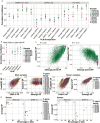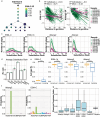Protein language model pseudolikelihoods capture features of in vivo B cell selection and evolution
- PMID: 40825239
- PMCID: PMC12360699
- DOI: 10.1093/bib/bbaf418
Protein language model pseudolikelihoods capture features of in vivo B cell selection and evolution
Abstract
B cell selection and evolution play crucial roles in dictating successful immune responses. Recent advancements in sequencing technologies and deep-learning strategies have paved the way for generating and exploiting an ever-growing wealth of antibody repertoire data. The self-supervised nature of protein language models (PLMs) has demonstrated the ability to learn complex representations of antibody sequences and has been leveraged for a wide range of applications including diagnostics, structural modeling, and antigen-specificity predictions. PLM-derived likelihoods have been used to improve antibody affinities in vitro, raising the question of whether PLMs can capture and predict features of B cell selection in vivo. Here, we explore how general and antibody-specific PLM-generated sequence pseudolikelihoods (SPs) relate to features of in vivo B cell selection such as expansion, isotype usage, and somatic hypermutation (SHM) at single-cell resolution. Our results demonstrate that the type of PLM and the region of the antibody input sequence significantly affect the generated SP. Contrary to previous in vitro reports, we observe a negative correlation between SPs and binding affinity, whereas repertoire features such as SHM and isotype usage were strongly correlated with SPs. By constructing evolutionary lineage trees of B cell clones from human and mouse repertoires, we observe that SHMs are routinely among the most likely mutations suggested by PLMs and that mutating residues have lower absolute likelihoods than conserved residues. Our findings highlight the potential of PLMs to predict features of antibody selection and further suggest their potential to assist in antibody discovery and engineering.
Keywords: B cells; antibodies; protein language models; repertoire; somatic hypermutation.
© The Author(s) 2025. Published by Oxford University Press.
Figures





Similar articles
-
Prescription of Controlled Substances: Benefits and Risks.2025 Jul 6. In: StatPearls [Internet]. Treasure Island (FL): StatPearls Publishing; 2025 Jan–. 2025 Jul 6. In: StatPearls [Internet]. Treasure Island (FL): StatPearls Publishing; 2025 Jan–. PMID: 30726003 Free Books & Documents.
-
Comparison of Two Modern Survival Prediction Tools, SORG-MLA and METSSS, in Patients With Symptomatic Long-bone Metastases Who Underwent Local Treatment With Surgery Followed by Radiotherapy and With Radiotherapy Alone.Clin Orthop Relat Res. 2024 Dec 1;482(12):2193-2208. doi: 10.1097/CORR.0000000000003185. Epub 2024 Jul 23. Clin Orthop Relat Res. 2024. PMID: 39051924
-
Short-Term Memory Impairment.2024 Jun 8. In: StatPearls [Internet]. Treasure Island (FL): StatPearls Publishing; 2025 Jan–. 2024 Jun 8. In: StatPearls [Internet]. Treasure Island (FL): StatPearls Publishing; 2025 Jan–. PMID: 31424720 Free Books & Documents.
-
The Black Book of Psychotropic Dosing and Monitoring.Psychopharmacol Bull. 2024 Jul 8;54(3):8-59. Psychopharmacol Bull. 2024. PMID: 38993656 Free PMC article. Review.
-
Behavioral interventions to reduce risk for sexual transmission of HIV among men who have sex with men.Cochrane Database Syst Rev. 2008 Jul 16;(3):CD001230. doi: 10.1002/14651858.CD001230.pub2. Cochrane Database Syst Rev. 2008. PMID: 18646068
Cited by
-
Nucleotide context models outperform protein language models for predicting antibody affinity maturation.bioRxiv [Preprint]. 2025 Jun 18:2025.06.16.659977. doi: 10.1101/2025.06.16.659977. bioRxiv. 2025. PMID: 40666976 Free PMC article. Preprint.
References
-
- Miho E, Yermanos A, Weber CR. et al. Computational strategies for dissecting the high-dimensional complexity of adaptive immune repertoires. Front Immunol [Internet] 2018;9. Available from: https://pubmed.ncbi.nlm.nih.gov/29515569/ - PMC - PubMed
LinkOut - more resources
Full Text Sources

